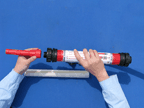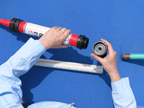Educational Videos

Wildfire Pre-Treatment Kit Assembly & Operation
Preventing Home Ignitions
This video is based on the research of Jack Cohen, U. S. Forest Service, Research Physical Scientist, at the Fire Sciences Laboratory of the USDA Forest Service in Missoula, MT. The program discusses how the combustion process effects forest fires, what you can do to create survivable space, why some homes are destroyed while others survive, how to identify your home's Ignition Zone - the area that includes the home and its immediate surroundings, which, if properly conditioned, can save the home during a wildfire.
Protecting Your Home From Wildfire
Jack Cohen, U.S. Forest Service, Physical Research Scientist, evaluates burn patterns and examines the potential source of home ignitions during the Bitterroot Fires in 2000. Jack offers homeowners practical suggestions to reduce the fuel load around their homes that could potentially save their homes.
Understanding Fire Behavior in the Wildland Urban Interface
The video is part of the Fire Fighter Safety Series. a multipart instructional package developed for small community fire departments to address the problems faced by structural and wildland firefighters when fighting fires, especially those threatening structures in the wildland/urban interface. Although geared towards the Professional Fire Fighter it contains many valuable lessons for those individuals developing a fire safety plan.
Using Water in the Wildland/Urban Interface
This training video for fire departments shows various approaches to using water wisely for reducing interface structure loss. Although geared towards the Professional Fire Fighter, the video is incredibly valuable and informative to show different ways of using water effectively in interface firefighting and provides examples of techniques or strategies including planning and locating water sources, accessing those water sources for supply; and testing and maintaining the source. Some of the tactics shown include: developing quick engine fill sites, making the best use of limited water, proper use of foams and gels, mobile water delivery using various extinguishing options, and site preparation to reduce water needs.
NOTE: The information contained on this page has been compiled from a variety of sources. No guarantee is made as to the accuracy of any of the information and the views expressed are offered only as general information with no guarantee as to accuracy for a specific application. Information contained on linked pages or videos are those of the respective authors and are not necessarily the opinions of Western DataLynx Inc, it's employees or dealers. Firefighting is serious business and we advise you to consult with your local fire agency for specific recommendations regarding fire safety in and around your home and property






